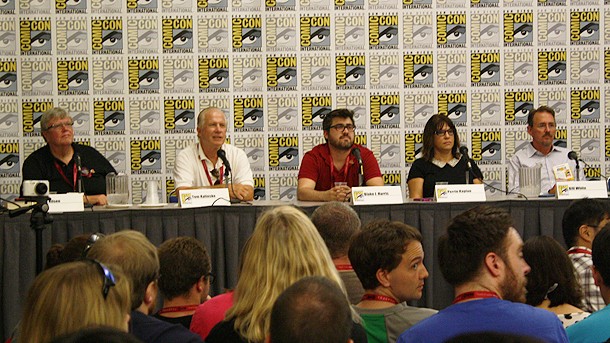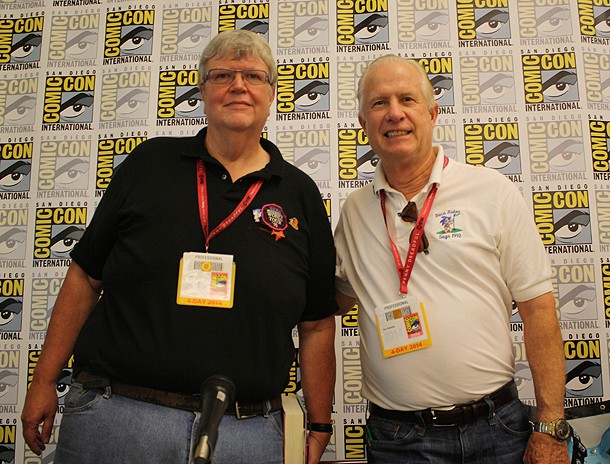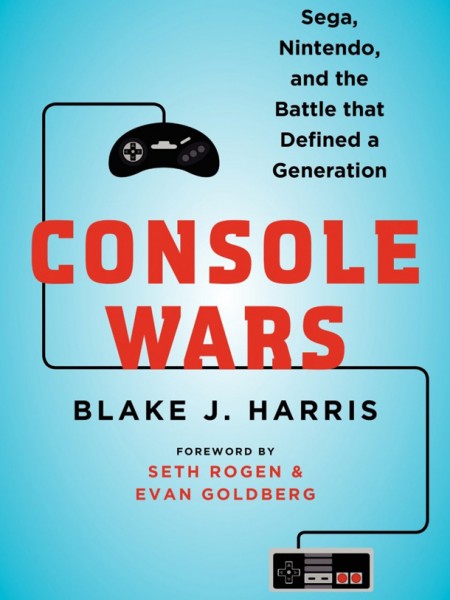Remembering The Sega Vs. Nintendo Rivalry With The People Who Lived It

A new book, Console Wars, recently released detailing the intense competition between Sega and Nintendo during the 16-bit era and a Comic Con panel of the same name discussed the rivalry and book.
On the panel was the author of Console Wars, Blake J. Harris, former Sega of America president Tom Kalinske, and former director of marketing Al Nilsen. Representing Nintendo of America was former director of marketing Bill White, and former vice president of marketing and corporate affairs Perrin Kaplan. The book tells the story of how Sega was able to push against Nintendo, which had a 95% share of the video game market during the 16-bit era, until Sega intervened.
Nilsen told a story about his first experience with Sonic. Sega was trying out a few mascots to represent its brand. One, Nilsen described, was an egg-shaped creature that looked like a pre-school toy. The other was a hedgehog with a rock band and a human girlfriend. Nilsen said he went with the lesser of two evils.
Kalinske, worked for a number of different companies and brands including Mattel, Flintstone vitamins, He-Man, and Barbie before making his way to Sega. It was Kalinske who made the decision to lower the price of the Genesis and package it with Sonic the Hedgehog, which was instrumental to the console's huge success.
White recalled how Nintendo was on a mission to revive the thought-dead video game industry. "Atari screwed Atari," White said of the collapse of Atari, and Nintendo was determined not to make the same mistakes.
White also recalled the process of making sure Super Mario Bros. 3 was featured in the film, The Wizard. He said he went to Universal Studios with the intention of selling the Mario license for use in a film. He was told by his bosses to not settle for anything less than $100,000. That meeting is what ultimately led to Super Mario Bros. 3's appearance in the film.
Kaplan knew nothing of the video game industry before working for Nintendo, and even admitted that when she first began the process of becoming part of the company, she thought she was going to interviewed by someone named Mario. Her lack of knowledge, however, was exactly what Nintendo was looking for. It wanted an outside perspective, and Kaplan was able to provide it. "I sell joy," is what Kaplan said she did for a living when asked during her time with Nintendo.
Everyone on the panel joked about the use of terms like Blast Processing, which were completely made up for use with marketing. When asked what Blast Processing did, Kaplan joked it did the same thing as the Super FX chip.
Sega valiantly pushed against Nintendo with its marketing, and though Nintendo rarely acted in kind, Kaplan said it did nearly decide to dump a dump truck full of bananas into Sega's parking lot to celebrate the release of Donkey Kong Country, but ultimately decided not to as it would require a huge amount of clean-up and would be an incredible waste of food.
Everyone on the panel said it enjoyed playing the games it sold. Nilsen said they were all gamers and played everything in the offices, including Nintendo games, but followed up saying, "We had more fun with Genesis..."

Nilsen and Kalinske say they still keep in touch after all these years.
Neither Kalinske, Nilsen, White, or Kaplan work for Sega or Nintendo any longer, but the panel did offer some thoughts on the modern video game industry. Regarding the Wii U falling behind the sales of PlayStation 4 and Xbox One, Kaplan pointed out that Nintendo has always done its own thing and that PlayStation 4 and Xbox One are ultimately similar products. "It's not really a three-horse race," said Kaplan, and said that the call for Nintendo to put its games on mobile devices is short sighted and would not be a good direction for Nintendo to take.
The panel closed with Nilsen lamenting that the Sega PlayStation never happened. The full story is outlined in Harris' book, but Sega almost worked out a partnership with Sony to release a console, but the plan never came together. Finally, before officially closing down, Nilsen shared that during his time at Sega, he had a framed copy of E.T. for Atari framed on the wall in his office. The box had five different price tags on it, ultimately landing at $1.99. Nilsen said he actually bought it half-off, only paying $0.99 for the cartridge. He kept the cartridge in his office as a reminder not to make crappy games. For more on Atari's collapse and E.T.'s role in Atari's failure, head here to read about our rough-cut screening of a documentary covering the topic we saw while here at Comic Con.
We recently had a chance to speak with Nilsen and Kalinske more in-depth about its rivalry with Nintendo, how it avoided Japan's interference with its marketing goals, and how there may have been a dartboard with Kalinske's face on it in Nintendo's offices. To read that feature, check out our Call of Duty: Advanced Warfare issue of the magazine. You can read the digital version by heading here.

Get the Game Informer Print Edition!
Explore your favorite games in premium print format, delivered to your door.
- 10 issues per year
- Only $4.80 per issue
- Full digital magazine archive access
- Since 1991










